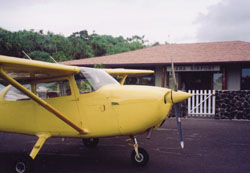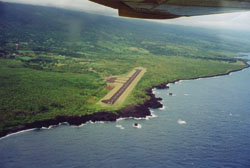|
|
 |
| SW Aviator Magazine is available in print free at FBOs and aviation-related businesses throughout the Southwest or by subscription. |

|
 |

|
 |
 |
 |
|
The web's most comprehensive database of Southwest area aviation events.
|

|
 |

|
 |
|
Featured Site:
|
|
|
 |
|
A continuosly changing collection of links to our favorite aviation related web sites.
|

|
 |

|
 |

|
 |
Search by:

|
|
|
Or enter a keword:

|
|
|
Post a FREE Classified Ad 
|
 |
|

 |
|
MAUI
|
 |
Story by Gerrit Paulsen, Photos by Dan Horn
 “Do you want to do a touch and go at the leper colony?” Now there’s a question I hadn’t heard crackling over an aircraft intercom before. After I responded with an enthusiastic “You bet!” the next helpful tidbit from my instructor was equally uncommon, “Okay, check the crosswind, and keep an eye out for big waves on final – they tend to break over the runway.” Oh yeah, this was going to be fun! “Do you want to do a touch and go at the leper colony?” Now there’s a question I hadn’t heard crackling over an aircraft intercom before. After I responded with an enthusiastic “You bet!” the next helpful tidbit from my instructor was equally uncommon, “Okay, check the crosswind, and keep an eye out for big waves on final – they tend to break over the runway.” Oh yeah, this was going to be fun!
We were motoring along the dramatic 3,000-foot sea cliffs of Molokai's north shore in a banana-yellow Cessna 172 that I had rented from Maui Aviators. My brother, Dan Horn, was in the back seat snapping pictures, while Anton Stammberger, our tour guide/instructor, was providing color commentary on the view out the window, punctuated by an occasional radio call. Just ahead, jutting from the rugged sea cliffs (the highest in the world) was the Kalaupapa Peninsula, a historical federal park that shelters Kalaupapa settlement, established in the late 1800s as a hospital for the treatment of Hansen's disease (Leprosy) patients. As we descended to the village’s small airstrip at the tip of the peninsula, Anton first pointed out Father Damien's historic church, and then the overgrown wreckage of a Baron that “Didn’t quite make it.” The plane wreck was not exactly a visual I needed on short final to an airport that boasts some of the most severe winds in Hawaii, but my touch and go turned out quite well nonetheless.
Of all the activities we had planned for our Hawaiian vacation, this flight is what I had dreamed of most. We were visiting Hawaii by cruise ship, spending a day or two at each major island. Our ship was in port in Maui for several days, so this seemed to be the most flexible opportunity to rent a plane. The fact that Maui County has some of the finest scenery in Hawaii was an unexpected bonus. A bit of research on the Internet before I left home resulted in a reservation with Maui Aviators, LLC, a full-service flight school and aircraft rental operation located in Kahului, Maui.
The Maui Aviators web site (mauiaviators.com) included an extensive, informative Maui County flight guide to prepare me for my trip, suggesting several sightseeing itineraries. I went for the all-inclusive 5-island Circle Maui County tour, which includes visiting Molokai and Lanai, as well as circumnavigating Maui. The web site also detailed their five aircraft fleet, to include pertinent V-speeds and gross weight limitations. Rental prices were posted as well; our 172L was going for $116 per hour wet, as did their 172M. For the economy-minded, the 152 Aerobat is $88, and, for the low-wing crowd, a Piper Archer ($127) and a Seneca II ($295) are also available. The flight instructor gets an additional $45 an hour over the rental fee. The 172L I flew seemed to be in good condition, sporting a fresh corrosion treatment and a brand new motor. The 172M was also being freshened up, receiving a new windshield on the day of our visit.
Just like many of the beautiful places in the Southwest, much of Hawaii’s splendor is also only visible by air. This, of course, explains the abundance of tour operators on the islands. However, a prepackaged tour can’t compare to the freedom, economy, and outright fun of flying yourself.
Every article I have read about flying Hawaii has advocated keeping the instructor on board after the initial checkout to act as tour guide. Excellent advice. Having Anton along allowed me to relax and enjoy the flying and sightseeing, while delegating the pesky details of airspace, communications, and navigation to him. This arrangement also absolved me of publicly humiliating myself trying to pronounce Hawaiian place names over the radio. You try sounding professional saying something like, “Kahului approach, Skyhawk 7813G is over Maalaea Bay, request Oluwalu transition to Kapalua”! In addition to his a mastery of Hawaiian pronunciation, Anton – who grew up in Maui – was absolutely brimming with local knowledge.
As we continued our adventure, Anton coordinated our transition over Molokai’s commercial airport while Dan and I admired the neatly organized rows of pineapple fields. A short dash over open ocean brought us to the island of Lanai, where we lazily circled a World War II vintage shipwreck, then ducked under the clouds topping the island to get a birds-eye view of the exclusive destination resorts of Club Lanai and the Koele Lodge over on the sunny side of Lanai.
On each leg of our trip, Anton updated our Island Flight Plan with Honolulu Radio. An Island Flight Plan differs from a traditional flight plan on the mainland in that you report in at each waypoint along your route, and provide an ETA to your next waypoint. If you do not make your next report at the planned ETA, Flight Service immediately begins their overdue aircraft procedures. This arrangement activates rescue forces sooner and helps pinpoint the search area, both important survival factors when in the water or trapped at the bottom of a jungle ravine.
 The next leg of our flight plan took us back over-water from Lanai to Maui, for an aerial view of our cruise ship anchored offshore at historic Lahaina town. Then, after a brief detour to the crater-shaped island of Molokini (a world famous snorkel and dive destination), we fought against the trade winds up Maui’s pristine eastern coast. The headwind gave us ample time to marvel at the ruins of ancient Hawaiian villages and home sites, dramatic lava formations, and multi-colored reefs in crystalline waters passing slowly below. As we neared the town of Hana, Anton pointed out the home that belonged to the great aviation pioneer Charles Lindberg, and the church where he is buried. The next leg of our flight plan took us back over-water from Lanai to Maui, for an aerial view of our cruise ship anchored offshore at historic Lahaina town. Then, after a brief detour to the crater-shaped island of Molokini (a world famous snorkel and dive destination), we fought against the trade winds up Maui’s pristine eastern coast. The headwind gave us ample time to marvel at the ruins of ancient Hawaiian villages and home sites, dramatic lava formations, and multi-colored reefs in crystalline waters passing slowly below. As we neared the town of Hana, Anton pointed out the home that belonged to the great aviation pioneer Charles Lindberg, and the church where he is buried.
My next landing in paradise was at the delightful little Hana airport. Anton suggested an observation pass before landing, both to check the winds, and to clear the runway of wild boars. After a pleasant rest in Hana, were hopped back into “Ole Yeller” for the short flight back to our starting point. It takes two to three hours to drive to Kahului from Hana on the traffic-choked road. We made it in 20 minutes, and were treated to breathtaking views of hidden waterfalls, lush green rain forests, and unobstructed views of the tropical estates of movie and rock stars overlooking the dramatic coastline.
Maui’s Kahului Airport is famous for its gusty trade winds, which blow through the valley created by 10,000-foot mount Haleakala to the east, and the 6,000-foot West Maui Mountains to the west. I was sequenced in ahead of a United 767 arriving from the mainland. After a near zero groundspeed touchdown in our STOL-equipped 172, I actually had to add power to coax enough of a rollout to clear the runway.
The flight had indeed been fun. We logged a total of 2.3 hours and 3 landings in paradise, and gathered a lifetime of pleasant memories.
To schedule your own touch ‘n go in paradise, contact Maui Aviators at 877-FLY-MAUI or 808-871-6990, or visit their extensive web site, mauiaviators.com. If you want to use an aircraft without an instructor, you must first complete a checkout. The checkout costs $55 plus the cost of the Hobbs meter flight time, and includes a comprehensive brief of the local airport, airspace, and VFR procedures, followed by a short local flight with an instructor to familiarize you with the area and the aircraft. Be sure to bring a current Medical, Pilot's Certificate, and proof of current Flight Review.
|
|
|
Click here to return to the beginning of this article.  |
|